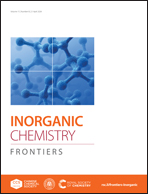N-heterocyclic carbene-stabilized Cu9 clusters with combined thermally activated delayed fluorescence and phosphorescence†
Abstract
Metal clusters with both phosphorescence and thermally activated delayed fluorescence (TADF) at room temperature, allowing for efficient light emission and a short lifetime, are of particular interest. However, such clusters remain rare due to the challenge of achieving comparable and effective transitions T1 → S1 → S0 and T1 → S0 simultaneously. Herein, we report two copper clusters, [Cu9{(py)2im}2(PhC![[triple bond, length as m-dash]](https://www.rsc.org/images/entities/char_e002.gif) C)4(CF3CO2)4](PF6) (Cu9-Ph) and [Cu9{(py)2im}2(tBuC
C)4(CF3CO2)4](PF6) (Cu9-Ph) and [Cu9{(py)2im}2(tBuC![[triple bond, length as m-dash]](https://www.rsc.org/images/entities/char_e002.gif) C)4(CF3CO2)4](PF6) (Cu9-TBA), for which the ambient-temperature emission stems from both TADF from the S1 state and direct phosphorescence from the T1 state in thermal equilibrium. At 300 K, about 69% of the emission intensity of Cu9-TBA originates from the delayed fluorescence of the S1 state, and an additional 31% is contributed by the T1 → S0 emission. In comparison, Cu9-Ph exhibits nearly equal contributions from delayed fluorescence and phosphorescence at room temperature. As a result, the overall decay time is significantly shorter than that observed in the TADF-only situation of these clusters (e.g., reduced by 49% for Cu9-Ph). The combined harvesting mechanism arises from the simultaneous presence of a small ΔE(S1 − T1) gap and relatively strong spin–orbit coupling induced by the multi-metal centers. The combined use of both decay processes makes the low-cost Cu(I) clusters promising for applications in organic light-emitting diodes.
C)4(CF3CO2)4](PF6) (Cu9-TBA), for which the ambient-temperature emission stems from both TADF from the S1 state and direct phosphorescence from the T1 state in thermal equilibrium. At 300 K, about 69% of the emission intensity of Cu9-TBA originates from the delayed fluorescence of the S1 state, and an additional 31% is contributed by the T1 → S0 emission. In comparison, Cu9-Ph exhibits nearly equal contributions from delayed fluorescence and phosphorescence at room temperature. As a result, the overall decay time is significantly shorter than that observed in the TADF-only situation of these clusters (e.g., reduced by 49% for Cu9-Ph). The combined harvesting mechanism arises from the simultaneous presence of a small ΔE(S1 − T1) gap and relatively strong spin–orbit coupling induced by the multi-metal centers. The combined use of both decay processes makes the low-cost Cu(I) clusters promising for applications in organic light-emitting diodes.



 Please wait while we load your content...
Please wait while we load your content...